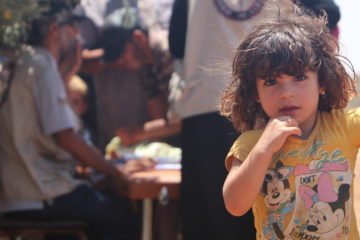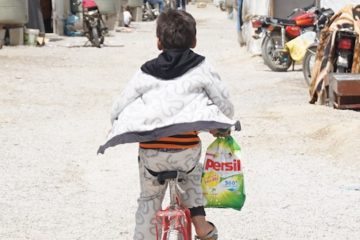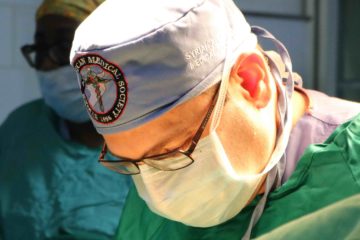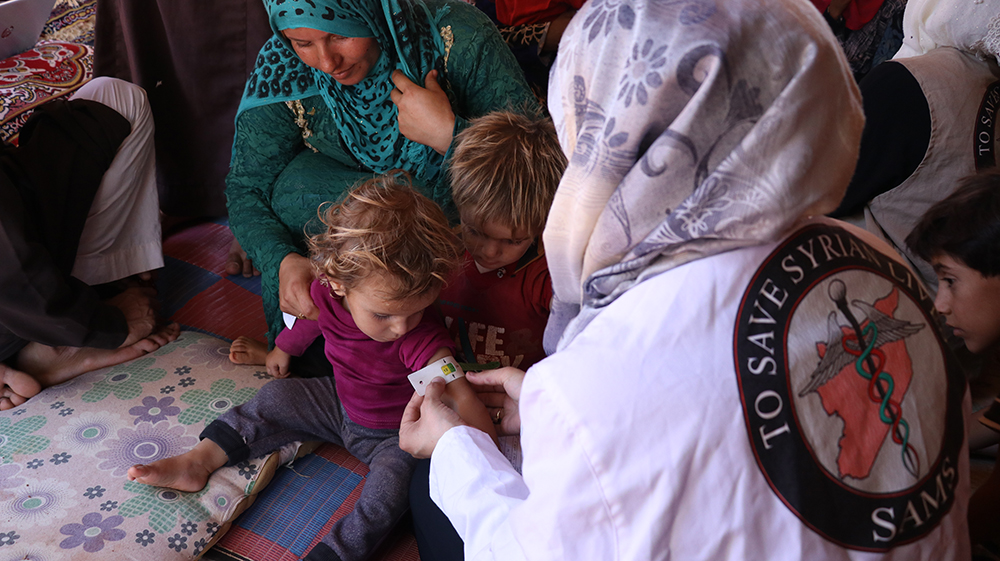June 24, 2014
By Dr. Zaher Sahloul
Aleppo, like the rest of Syria, is facing a humanitarian tragedy of unprecedented proportions. By then end of the Syrian crisis, Aleppo as we know it may cease to exist. Relentless bombing by barrel bombs, indiscriminate shelling of civilian neighborhoods, destruction of historic landmarks, displacement of the diverse population and barbaric sniper attacks against helpless civilians is erasing the face of a city that lasted for thousands of years.
In the last day of my medical mission to the city at the end of October 2013, I was asked to examine an unfortunate toddler who had arrived at the hospital after being shot in the head by a sniper one hour earlier. His name was Hamza Ramadan, and he was just three years old. His heart was beating but he had no other signs of life. His mother, sister, and he were targeted by snipers while they were trying to sprint through the “corridor of death” from the opposition-controlled east side of Aleppo, to the regime-controlled part. The two-block corridor earned its name, not from the imaginary victims from Call to Duty 3 Video game, but from of the large number of real murdered civilians hit by snipers from the regime controlled buildings. Hamza’s mother and sister were killed instantly and their bodies, and that of Hamza, were rushed to my hospital by some bystanders in the back of their car. Ambulances are luxury in Aleppo as most of the functioning ones have been targeted by the regime and destroyed. According to the World Health Organization, more than 75% of Ambulances in Syria have been damaged during the conflict.
As physicians we try to keep a distance between our patients and our emotions, most of the time we succeed but some patients overwhelm these boundaries. I find it difficult to erase the faces of young innocent patients hit by sniper bullets or blown up by a barrel bomb from my mind. In Syria today, there are plenty of young innocent victims and Hamza is one of them.
The vast majority of patients at the hospital I visited code-named “M-1,” were victims of barrel bombs or sniper attacks.” I visited M-1 along with a group of volunteers working for the Syrian American Medical Society, an NGO that has been a pioneer in providing medical assistance — in the form of medical supplies, volunteer physicians, and job training for Syrian doctors and nurses — to fill the gap in the war zone’s disintegrating healthcare system. The mission still haunts me. This was my eighth visit to Syria since the beginning of the government crackdown in 2011 and the ensuing civil war. As SAMS’ medical volunteer, I train my Syrian colleagues in disaster management, trauma care, chemical agents’ exposure and dealing with limited resources among other things. No amount of training, no matter how extensive, can prepare a US-based clinical practitioner to deal with the painful realities in Syria. As a Chicago-based critical care specialist, I am trained to deal with very sick patients, to use all of my knowledge and plenty of resources to save the lives of my patients. Death is accepted as an inevitable outcome only when all measures and interventions are exhausted. In Syria, the situation is totally different, Syrian doctors have to work within unimaginable stressful situations, most of the time in underground field hospitals facing the threat of being bombed every minute and dealing with very sick patients with limited resources. Every day, Syrian doctors have to face the painful reality that not all of their salvageable patients can be saved. They have to choose, or triage, who will be saved and who will be left to die due to limited resources. Patients may die for simple reasons, like shortage of life saving antibiotics or blood products or the inability to transport them in a timely manner to a functioning hospital, or just because they overwhelm a system that is near collapse.
According to UK-based, Oxford Research Group, in its report, Stolen Futures: The Hidden Toll of Child Casualties in Syria, 11,420 children (aged 17 and under) were recorded killed in the conflict by end of August 2013, from an overall total of 113,735 civilians and combatants killed. Seven out of every 10 child deaths was caused by explosive weapons while small arms fire accounted for one in 4 child deaths, including children summarily executed and targeted by snipers. Hamza was just one of the children targeted by snipers.
Every day thousands of civilians in Aleppo put their lives in danger attempting to cross the “corridor of death”, a third-of-a-mile stretch in the neighborhood Boston al-Qasr. According to Aleppo Civilian Medical Council, 5 to 20 civilians are gunned down each day by snipers perched on the roofs of three towering government buildings overlooking the corridor. Most of the victims die instantly, and those who survive are likely to suffer lifelong disabilities: amputations, loss of an eye, or spinal cord injury and paralysis are just few on a long list of possibilities.
For many Aleppoians venturing to the other side of the city is not optional. Some have to take the game on their daily commutes back and forth from work; others have to venture to the eastern side’s farmers market to buy food and fuel; others still make the perilous journey to visit their families stuck on the other side of the crossing.
According to Aleppo doctors, the snipers do not limit their targets to fighters, opposition leaders, and young men, but they unashamedly target civilians: women, children, and the elderly. And worse, several of M-1’s doctors saw ruthless and sadistic patterns in the snipers’ targets. One day they target children, the next day, they shoot all of their targets in the eye; and then, they target their victims’ spines or chests. From the many stories I have heard, it sounded that the snipers’ intentions were not merely to alarm Aleppoians with the threat of random violence — but to spread fear and cause permanent disability and death. I was told that some snipers, probably bored by long hours of scouting for targets, played games, challenging themselves to hit two people with one bullet, or picking off stray cats and dogs.
David Nott, a British Trauma surgeon, who has spent five weeks volunteering in the same hospital, said each day snipers would chose to aim at different parts of the civilians’ bodies as they ran from one part of the city to another to buy food and supplies. One day it would be the groin, one day it would be the neck, the next it would be the chest, he told The Times. “From the first patients that came in in the morning, you could almost tell what you would see for the rest of the day. It was a game. We heard the snipers were winning packets of cigarettes for hitting the correct number of targets.” On one day more than six pregnant women were caught by sniper fire and on another day two heavily pregnant women were targeted. They survived but their unborn babies died, one suffering a bullet to the brain. “The women were all shot through the uterus, so that must have been where they were aiming for… This was deliberate. It was hell beyond hell,” he told the paper. His picture of unborn baby with a bullet lodged in the head was widely-distributed http://www.telegraph.co.uk/news/worldnews/middleeast/syria/10390430/Assad-regime-snipers-targeting-unborn-babies.html. Both the mother and her unborn child were pronounced dead at M-1.
Almost every doctor I met in my visit to the M1 hospital, told me another horrific story about a young mother who tried to make the crossing with her two children. When she hastened through the crossing holding one child in each hand, a sniper targeted her first 4-year-old son, killing him instantly. She started screaming in agony. Then, a second bullet hit her second son, a 3-year-old, and killed him. She sat down between the bodies of her two sons, waiting for the sniper to kill her — but he did not. He spared her to live a life consumed by a gnawing emptiness. When she finally arrived at M-1 with the dead bodies of her only two children, she was in the midst of a complete psychiatric breakdown.
Snipers have played an important role in the modern battlefield, especially since new technology, such as infrared vision and long range guns, made the task of remote killing much easier. And, usually, civilians bear the brunt of sniping. During the Bosnian war, Serbian snipers gunned down civilians trying to cross Sarajevo’s infamous Vrbanja Bridge. The Sarajevo’s sniper alley, was a treacherous place, where the bodies of Sarajevo’s “Romeo and Juliet” – he was a Serb, she a Muslim – lay entwined for five days in May 1993. The road was overlooked by the tall buildings favored by sharp-shooters. The young couple was shot dead by snipers while trying to flee the city. The international media covered such incidents widely. But unlike the Serbian snipers in Sarajevo, Syria’s snipers are acting without much media attention. Aleppo is not as accessible to journalists as Sarajevo and Syrian victims are no “Romeo and Juliet”. Thus, Syrian snipers operate with near complete impunity, targeting women and children, killing just to spread fear, hatred, and vengeance.
It all started in the heart of Houran province in southern Syria in March of 2011. Syrian security forces, or mukhabarat, detained 15 middle school students and subjected them to hours of torture, pulling their nails off just because they wrote graffiti on the walls of their school reading: “The people demands changing the regime.” When the people of Daraa took to the streets to demand the release of the young boys, snipers were waiting for them. http://www.youtube.com/watch?v=21uILDiCgMg. Government snipers stationed in tall building nearby killed four protesters and injured dozens of others. http://www.theguardian.com/world/2011/mar/22/syrian-protests-troops-kill-deraa. Hundreds of Youtube videos http://www.youtube.com/watch?v=DqfVzHbeSRY documented the killings, some even capturing the snipers themselves.
The regime used snipers, along of other measures of intimidation and terror, from the start of the Syrian nonviolent reform demonstrations in March 15th, 2011 in order to scare the demonstrators, prevent others from joining them and provoke violent response. When the Tunisian and Egyptian regimes hesitated to use force against demonstrators, hundreds of thousands of discontented youth descended to the streets and public squares during the early days of the Arab spring forcing regime changes. The Syrian regime had time to learn from the mistakes of Ben-Ali of Tunisia and Mubarak of Egypt and plan accordingly. When the early demonstrators arrived finally to the streets of Daraa, Homs and Banias, snipers were awaiting with live bullets. Many early Youtube videos showed demonstrators hit by large caliber bullets, carried on the backs of the demonstrators and rushed to hospitals nearby. Next, hospitals were targeted and injured patients were pulled from the Operating rooms and Intensive Care Units by ruthless security agents. Many of them were tortured to death. Doctors who treated these patients were detained, tortured and forced to flee.
Administering medical care has become a challenge as doctors struggle to keep up with the casualties. At the same time, Syrian security forces have imposed tight control over many public hospitals, impeding their access to the injured and wounded. Doctors established field hospitals out of necessity. Activists brought the wounded to the nearest field hospitals, which were often hidden in farmhouses, mosques, the basements of deserted buildings, and even natural caves, where courageous doctors were able to perform even complicated surgeries. Over time, activists began to carry arms to protect themselves and their patients from snipers. Gradually, they organized into local battalions to protect their villages or neighborhoods.
What has started as a peaceful call for reforms has ended up in never-ending civil war: the regime, its allies, and snipers on one side, and the people who were forced to carry arms, their allies and their snipers on the other side. The Syrian civilians and children were caught in the middle. To make matters worse, extremist groups have joined the already complicated fray, instigating more chaos, and exploiting the void created by the absence of the international community. As we are approaching the third anniversary of the first peaceful demonstrations and entering the second round of the Geneva peace talks, no one expects a close end to the crisis. If anything, there is an intensification of the aerial bombing campaign in Aleppo and around Damascus as the regime tries to assert itself on the ground to have the upper hand on the negotiating table.
Syria, the country of my childhood and youth, the country I love, has changed forever. “Send us Coffins” uttered Dr. Abdel Aziz, the medical director of M-1 as I was leaving the hospital at the end of my mission. He was not joking. In his long list of life saving items, there were different surgical and medical items from surgical gloves, antibiotics, chest tubes and surgical sets to more complicated equipment like CT-Scanner and Blood lab. Then he added: “We also need coffins, we ran out of them. We have more dead bodies than cloth to wrap them”.




